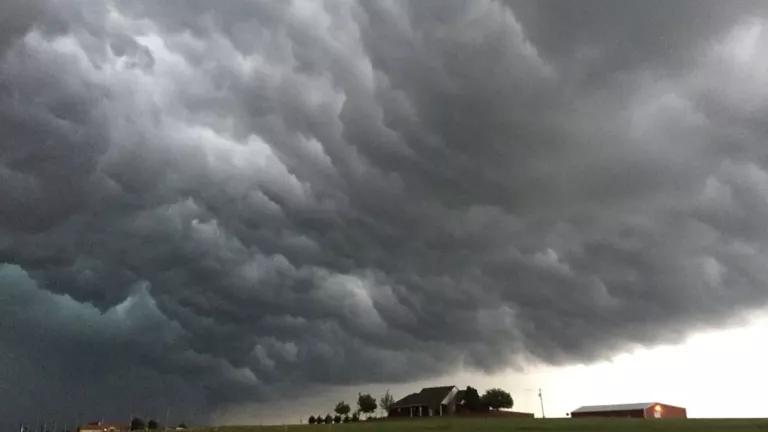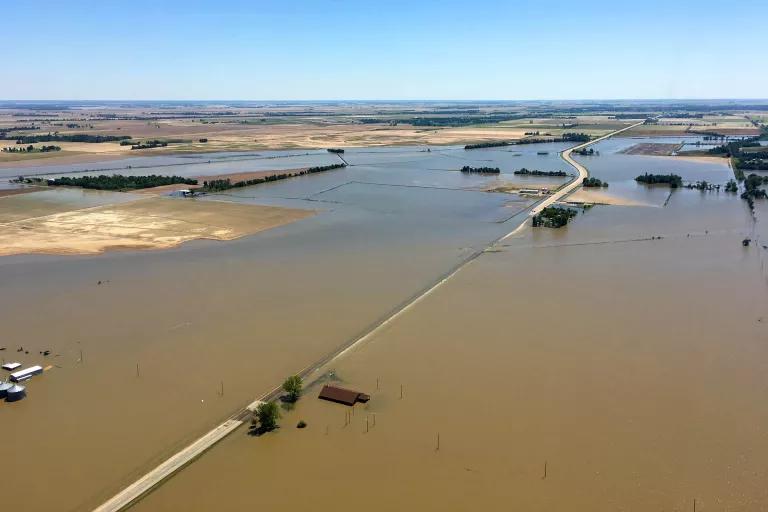7 Ways to Flood-Proof Your House
As floods become more frequent and severe with climate change, protecting your home becomes even more crucial. Here’s how to assess your risk—and make sure you’re prepared for the worst.

Storm clouds over a home near Meers, Oklahoma
Rising sea levels, heavier and more frequent downpours, and a national landscape paved with asphalt are making homes more vulnerable to flood damage than ever before. Think of this past summer’s harrowing, record-breaking floods in Louisiana, or of FEMA’s recent prediction that areas at risk of flooding in the United States will increase, on average, by 45 percent by 2100. Indeed, in the past 12 months, we’ve seen eight flood events of a size expected to occur just once every 500 to 1,000 years, says Joel Scata, project attorney and water policy advocate for NRDC. These include floods in Texas, South Carolina, and West Virginia.
“Often, these are impacting areas where people think they’re safe from flooding,” Scata says. “While not everyone lives in a high-risk area, everyone lives in a potential flood zone.” Flood damage can range from the somewhat manageable—say, a waterlogged garden or a few inches of backup stormwater in the basement—to the full-scale destruction of a home. Even relatively minor damage, like a wrecked hot water heater, can cost thousands of dollars to repair. But community members and homeowners do have some ways to mitigate the damage.
Evaluate your risk.
Homeowners and renters can begin gauging their current flood risk by visiting Floodsmart.gov, the website of the National Flood Insurance Program (NFIP). This federal program sets flood insurance rates using FEMA’s Flood Insurance Rate Maps, which show a community’s base flood elevations, flood zones, and floodplain boundaries. Any home within a so-called 100-year floodplain, an area with a 1 percent chance of flooding in any given year, is deemed at risk.
But “FEMA maps should be a starting point, not an end point, in your research,” cautions Chad Berginnis, executive director of the national Association of State Floodplain Managers. The maps haven’t kept pace with climate change, and though they’re continually updated, “at best, FEMA has mapped maybe a third of the floodplains in the country,” he notes.
If you’re considering buying a home, find out whether the property has ever been flooded. Some states require real-estate records to include that information. Better yet, Berginnis says, “Ask the neighbors, especially if they’ve been there for decades, whether there’s been flooding in the area.”

Buy flood insurance.
If you live within a 100-year floodplain, flood insurance is a must. Anyone with a federally backed mortgage who lives in a flood zone is required by law to carry insurance. People in high-risk areas often assume that government-issued disaster assistance will cover the cost of damage from a flood. In fact, Scata says, emergency funds are seldom adequate, and standard insurance policies don’t cover water damage caused by extreme weather. Moreover, “there’s a false assumption that if you live outside a flood zone, you don’t need insurance,” he says. “But 25 percent of flood insurance claims are made by people who live beyond those zones.” Berginnis recommends that everyone, including apartment dwellers, have at least enough flood insurance to cover the contents of their homes.
Elevate your boiler.
Utilities, boilers, central air-conditioning units, and other HVAC equipment normally located at the lowest level of a home are particularly vulnerable to flood damage. Consider bringing them to higher ground, either by building platforms, if your flood risk is minimal, or by moving them to another floor. Your insurance agent and a contractor can advise on logistics and cost.
Install a sewage water backstop.
Cities that deal with persistent and costly stormwater flooding, like Chicago, have various municipal programs to fund the installation of backflow prevention valves and other devices that keep overtaxed sewer mains from backing up into basements. If your basement floor drain backs up after heavy rains, consider installing one of these devices with help from a licensed plumber.
Change your landscaping.
Porous outdoor surfaces help water seep into the ground instead of streaming toward your home. Digging depressions known as swales to channel stormwater runoff away from your house, converting concrete or asphalt driveways to gravel or brick, and using absorbent mulch can help manage heavy rain and reduce potential flood damage. Placing a rain barrel beneath a gutter downspout will not only allay basement flooding but also help reduce flooding and pollution of local waterways.

Consider relocating.
“It can be hard to contemplate moving, but sometimes it’s the best option, especially for people in coastal communities facing sea level rise,” Scata says. If you can move preemptively, you could save tens of thousands of dollars in repair costs and avoid the trauma of repeated flooding and rebuilding.
If your home is vulnerable to flooding, check with your regional FEMA office to see if you’re eligible for a buyout program for “repetitive loss properties.” In some cases, the government will even buy a house for its pre-disaster market value. This helps move people out of harm’s way, reduces the drain on flood management resources, and prevents a new house from being built on that site in the future (the land is usually returned to a natural state).
Demand change.
Even with the realities of climate change, government agencies are still looking to the past to predict the flooding of the future. “That’s like driving down a highway and mapping your route by looking in the rearview mirror,” Scata says. Contact your community or county emergency management office or a local environmental group to support more sustainable development, including public landscapes with natural and water-permeable surfaces and smarter urban stormwater infrastructure. “There’s only so much one person can do alone,” Scata says. Our collective efforts are indispensable to making our communities more resilient.
This NRDC.org story is available for online republication by news media outlets or nonprofits under these conditions: The writer(s) must be credited with a byline; you must note prominently that the story was originally published by NRDC.org and link to the original; the story cannot be edited (beyond simple things such as grammar); you can’t resell the story in any form or grant republishing rights to other outlets; you can’t republish our material wholesale or automatically—you need to select stories individually; you can’t republish the photos or graphics on our site without specific permission; you should drop us a note to let us know when you’ve used one of our stories.
Flooding and Climate Change: Everything You Need to Know
Mapping Urban Heat Islands Is Helping These Neighborhoods Adapt
Poets Imagine a Different Climate Narrative